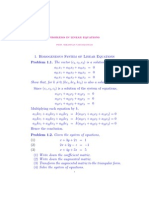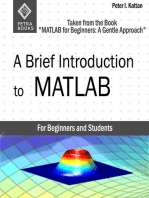Math 308 Solutions
Math 308 Solutions
Uploaded by
Wala Abu GharbiehCopyright:
Available Formats
Math 308 Solutions
Math 308 Solutions
Uploaded by
Wala Abu GharbiehOriginal Description:
Copyright
Available Formats
Share this document
Did you find this document useful?
Is this content inappropriate?
Copyright:
Available Formats
Math 308 Solutions
Math 308 Solutions
Uploaded by
Wala Abu GharbiehCopyright:
Available Formats
Math 308 Solutions
Sec. 1.1
Problems(1,5,11,12,13,19,23,) page 1 More Problems(24,27,30,31,33,35,38)
1.1.1 Is x 1 + 2 x 3 = 3 linear? Sol. Yes, since it has the form of (1) (i.e. a1 x 1 + a2 x 2 + a3 x 3 = b1 ) with a1 = 1, a2 = 0, a3 = 2 and b1 = 3. 1.1.5 Is | x 1 | | x 2 | = 0 linear? Sol. No, since it does not have the form of (1). | x 1 | is NOT a constant multiple of x 1 . 1.1.11,12,13 Sketch graph and use them to determine whether the systems has a unique solution, no solution or innitely many solutions. Sol. 11 Graph of y = 5 2 x is line of slope 2, of y = x 1 is line of slope 1. They meet at exactly ONE point. (See graphs in text answer p. AN1). Sol. 12 Graphs of y = 2 x + 1 and y = 2 x 2 have same slope, but different intercepts. So they are parallel and there is NO (common) solution to both equations. (See graphs in text). Sol. 13 Graphs of 3 x + 2 y = 6 and 6 x 4 y = 12 are the same line, so INFINITELY many solutions. (See graphs in text.) (Note solving for y in both leads to y = 3 (3/2) x . This is analytic verication of the graphical fact that two lines are parallel and coincident.) 1.1.19Display the (2 3) matrix A = ( aij ) (I (DLR) would write A = [ aij ]) where a11 = 2, a12 = 1, a13 = 6, a21 = 4, a22 = 3, and a23 = 8. 2 1 6 Sol. Since aij means entry in ROW i and COLUMN j , A = . 4 3 8 1.1.23Suppose the matrix A in Problem 19 is the augmented matrix for a system of linear equations. Display the system. Repeat for the matrix Q = (q ij ) in Problem 21, where q 23 = 1, q 32 = 2, q 11 = 1, q 13 = 3, q 22 = 1, q 33 = 1, q 21 = 2, q 12 = 4, and q 31 = 3. Sol. For 19, since A is (2 3) the linear system is 2 2, i.e., has 2 equations with 2 unknowns, and the RHS (right hand side) comes from the third column a13 and a23 . Heres the system: x2 = 3 2 x1 + . 4 x1 + 3 x2 = 8 For 21, since Q is (3 3) the linear system is 3 2, i.e., has 3 equations with 2 unknowns, and the RHS (right hand side) comes from the third column q 13 = 3, q 23 = 1, and q 33 = 1. Heres the system: x 1 + 4 x 2 = 3 1. x2 = 2 x1 + 1 3 x1 + 2 x2 = x x 2 = 1 1.1.24Display the coefcient matrix A and the augmented matrix B for the system 1 . 3 x1 + x2 = 1 1 Sol. The coefcient matrix has one column with the coefcients of each unknown, so A = . The aug1 1 1 1 1 mented matrix adds a column with the RHSs: B = . 1 1 3 x1 1.1.27Same as Problem 24 but for the system: 3 x 1 x1 x2 + + 4 x2 x2 + + + 2 x3 x3 x3 = = = 6 5. 2
Math 308 Solutions
Sec. 1.1 1 A= 3 1 1 4 1 2 1 . 1
Problems(1,5,11,12,13,19,23,) page 2
Sol. Coefcient matrix from unknowns:
Augmented matrix adds the RHSs:
2 6 1 1 B = 3 4 1 5 . 1 2 1 1 In 30-35 display the augmented matrix for the given system. Use elementary operations on equations to obtain equivalent system with x 1 in rst equation with coefcient one and has been eliminated from the remaining equations. Simultaneously perform the corresponding elementary row operations on the augmented matrix. Sol. 1.1.30 2 4 6 Augmented matrix : B = . 4 1 7 Elementary operations on system to eliminate x 1 : 2 x 1 + 3 x 2 = 6 (1/2)E1 x 1 + (3/2) x 2 = 4 x1 x 2 = 7 ===> 4 x 1 x2 = The elementary row ops corresponding to these are: 2 4 3 1 6 (1/2)R1 1 7 ===> 4 3/2 3 ===> 1 7 R2 4R1 0 3/2 7 3 . 5 3 7 ===> E2 4E1 x1 + (3/2) x 2 7 x2 = = 3 . 5
1 2 1 1 Augmented matrix : B = 1 1 2 2 . 0 4 2 1 Elementary operations on system to eliminate x 1 : x1 + 2 x2 x 3 = 1 ===> x1 + 2 x2 x2 x 2 + 2 x 3 = 2 E2 E1 x1 + + 5 x2 = 4 E3 + 2E1 x2 2 x 1 + The elementary row ops corresponding to these are: 2 1 1 1 2 1 1 ===> 1 1 1 2 2 R2 R1 0 1 3 1 . 0 4 R3 + 2R1 0 5 2 6 2 1 Sol. 1.1.33 1 9 1 Augmented matrix : B = 1 1 7 . 1 6 3 Elementary operations on system to eliminate x 1 : 9 x2 = x1 + x 1 + x 2 = 9 ===> 2 . 2 x2 = x 1 x 2 = 7 E2 E1 2 x 2 = 21 3 x 1 + x 2 = 6 E3 3E1 The elementary row ops corresponding to these are:
Sol. 1.1.31
x3 3 x3 + + 2 x 3
= = =
1 1. 6
Math 308 Solutions 1 1 3 1 1 1 9 ===> 1 7 R2 R1 0 6 R3 3R1 0 1 2 2 9 2 . 21
Sec. 1.1
Problems(1,5,11,12,13,19,23,) page 3
1 1 3 0 1 Augmented matrix : B = 1 2 1 1 1 . 7 1 0 1 1 Elementary operations on system to eliminate x 1 : x2 + x 3 x 4 = 3 E 1 <--> E 2 x1 + 2 x2 x 3 + x 4 = 1 ===> x1 + 2 x2 x3 + x4 = 1 x2 + x3 x4 = 3 x1 + x2 + 7 x3 x4 = 0 x1 + x 2 + 7 x 3 x 4 = 0 E3 + E1 x1 + 2 x2 x3 + x4 = 1 x2 + x3 x4 = 3 . 3 x2 + 6 x3 = 1 The elementary row ops corresponding to these are: 1 1 ===> 1 2 1 1 1 1 1 3 R1 <--> R2 1 2 1 0 1 1 2 1 0 1 1 1 3 0 1 1 1 3 . 1 1 7 1 0 R3 + R1 0 3 6 0 1 7 1 0 1 1 1 1 a11 x 1 + a12 x 2 = b1 1.1.38Show that the system , when a1122 a12 a21 0, is equivalent to a21 x 1 + a22 x 2 = b2 c 11 x 1 + c 12 x 2 = d 1 with c 11 0 and c 22 0. + c 22 x 2 = d 2 Sol. Try to use elimination. If a11 ! = 0 then the row operations on the associated augmented matrix: b1 / a11 a12 / a11 x 2 = x 1 + a12 / a11 x 2 = b1 / a11 ===> x 1 + 1/ a11 E 1 ===> a 21 x 1 + b2 E 2 a21 E 1 + a22 ( a21 a12 / a11 ) x 2 = b2 ( a21 b1 / a11 ) a22 x 2 = show the associated system are equivalent. The system associated with the last (augmented matrix) has the desired form with c 11 = 1( 0), c 12 = a12 / a11 (ok as a11 0 means division ok, and c 22 = ( a11 a22 a21 a12 )/ a11 ( 0) as division ok and a11 a22 a21 a12 ) 0 is given. If a11 = 0, then swapping the two equations yields: a21 x 1 + a22 x 2 = b2 which has the desired form with c 11 = a21 , c 22 = a12 , and c 12 = a22 . Now all + a12 x 2 = b1 thats left is to verify c 11 0 and c 22 0. But a11 = 0 means 0 0 a22 a12 a21 , i.e. a12 a21 0. Hence 0 a12 (= c 22 ) and 0 a21 (= c 11 ).
Sol. 1.1.35
You might also like
- MAT1503 Exam SolutionsDocument93 pagesMAT1503 Exam Solutionsd_systemsuganda100% (1)
- Math Paper 3 Practice MSDocument47 pagesMath Paper 3 Practice MSRaahish KalariaNo ratings yet
- Power System Analysis II: Instructor: E-Mail: Office PhoneDocument66 pagesPower System Analysis II: Instructor: E-Mail: Office PhoneSelah TalepNo ratings yet
- Chapter 03Document69 pagesChapter 03Wala Abu GharbiehNo ratings yet
- Role Play Script PrintDocument6 pagesRole Play Script PrintAyu Lisna Pratiwie83% (6)
- Human Rights Education and TrainingDocument26 pagesHuman Rights Education and TrainingSwajeet SaranNo ratings yet
- Lesson 2Document33 pagesLesson 2strom89No ratings yet
- Chapter 5 SlidesDocument112 pagesChapter 5 SlidesSingh KaranNo ratings yet
- Solved Problems in Linear EquationsDocument9 pagesSolved Problems in Linear EquationsSebastian VattamattamNo ratings yet
- System of Linear Equations: Direct & Iterative MethodsDocument36 pagesSystem of Linear Equations: Direct & Iterative MethodsLam WongNo ratings yet
- Solve System of Equations Using GraphingDocument42 pagesSolve System of Equations Using Graphingapi-265481804No ratings yet
- Introduction To Linear AlgebraDocument90 pagesIntroduction To Linear AlgebraEbrahem BarakaNo ratings yet
- Systems of Linear EquationsDocument39 pagesSystems of Linear EquationsRainingGirlNo ratings yet
- Lecture 2 Linear SystemDocument12 pagesLecture 2 Linear SystemEbrahim Abdullah HanashNo ratings yet
- 8 2 Solv Simul Linr Eqn Inv MTRX MTHDDocument9 pages8 2 Solv Simul Linr Eqn Inv MTRX MTHDEbookcrazeNo ratings yet
- ch3 PDFDocument20 pagesch3 PDFJaskirat SinghNo ratings yet
- Gauss JordanDocument44 pagesGauss JordanmomongaNo ratings yet
- 7 4Document11 pages7 4Conceição VilellaNo ratings yet
- Antonchap1 Linsys ExercicesDocument5 pagesAntonchap1 Linsys Exercicesapi-261282952No ratings yet
- Leon 8 ErrataDocument17 pagesLeon 8 ErrataMichael DavisNo ratings yet
- Lesson Note On Linear Algebra II by MR Ugoala B.CDocument24 pagesLesson Note On Linear Algebra II by MR Ugoala B.Cugoala brightNo ratings yet
- Numerical Methods: Dr. Nasir M MirzaDocument27 pagesNumerical Methods: Dr. Nasir M MirzaarafatasgharNo ratings yet
- Linear Algebraic Equations: N' Ax C A' NXN' C' nx1' X' nx1' LUDocument85 pagesLinear Algebraic Equations: N' Ax C A' NXN' C' nx1' X' nx1' LUThangadurai Senthil Ram PrabhuNo ratings yet
- Introduction To Financial Econometrics Appendix Matrix Algebra ReviewDocument8 pagesIntroduction To Financial Econometrics Appendix Matrix Algebra ReviewKalijorne MicheleNo ratings yet
- Chapter 2: Graphs of Functions Ii: 11.1: Linear FunctionDocument30 pagesChapter 2: Graphs of Functions Ii: 11.1: Linear FunctionksganNo ratings yet
- Solving Simultaneous Equations Using The Inverse Matrix: PrerequisitesDocument20 pagesSolving Simultaneous Equations Using The Inverse Matrix: PrerequisitesPrithviraj NetkeNo ratings yet
- 2) Solving - Linear - SystemsDocument19 pages2) Solving - Linear - SystemsSümeyyaNo ratings yet
- Lin 3037Document8 pagesLin 3037Worse To Worst SatittamajitraNo ratings yet
- Exercise 1correctedDocument5 pagesExercise 1correctedladheedhaNo ratings yet
- Systems of Linear Equations and Matrices: Shirley HuangDocument51 pagesSystems of Linear Equations and Matrices: Shirley HuangShu RunNo ratings yet
- Chapter 5Document25 pagesChapter 5Omed. HNo ratings yet
- Sia3e SSM 03Document106 pagesSia3e SSM 03brianNo ratings yet
- Worksheet (Numerical) I 2021Document4 pagesWorksheet (Numerical) I 2021natnaelNo ratings yet
- Module 2 Systems of Linear Equations and InequalitiesDocument20 pagesModule 2 Systems of Linear Equations and Inequalitiesjean100% (1)
- Equation MatrixDocument24 pagesEquation MatrixShubham YadavNo ratings yet
- Bab 2 - Linear Algebra and Matrix Analysis For Statistics (2014, CRC Press)Document30 pagesBab 2 - Linear Algebra and Matrix Analysis For Statistics (2014, CRC Press)dilafara152No ratings yet
- Systems of Linear Equations WorkbookDocument41 pagesSystems of Linear Equations WorkbookJay-Jay JapsNo ratings yet
- Linear AlgebraDocument12 pagesLinear AlgebraSivanathan AnbuNo ratings yet
- W1-1 Linear SystemsDocument26 pagesW1-1 Linear SystemsEmanuel JheadNo ratings yet
- Problem Set 1Document4 pagesProblem Set 1Ray Fellix GanardiNo ratings yet
- 2020 - 07. Sistem Persamaan LinierDocument35 pages2020 - 07. Sistem Persamaan LiniersindunugrohoNo ratings yet
- Lec05 SystemsDocument36 pagesLec05 Systemsadi.s022No ratings yet
- MX3 Math ReviewerDocument24 pagesMX3 Math ReviewerJuliana PeninoyNo ratings yet
- Lin1 Ex1Document2 pagesLin1 Ex1Evgeny ZakharovNo ratings yet
- Workshop 1: Solving Linear EquationsDocument37 pagesWorkshop 1: Solving Linear EquationsDaksh ParasharNo ratings yet
- Chapter 2Document53 pagesChapter 2LEE LEE LAUNo ratings yet
- MM2 Linear Algebra 2011 I 1x2Document33 pagesMM2 Linear Algebra 2011 I 1x2Aaron LeeNo ratings yet
- SimultaneousDocument27 pagesSimultaneousLatchmi DeviNo ratings yet
- Errata Leon 8 EdDocument12 pagesErrata Leon 8 EdAnjali SinghNo ratings yet
- Lab 2 SolnsDocument5 pagesLab 2 SolnsDPNo ratings yet
- Algebra y Geometr Ia Anal Itica: Ing. Electr Onica, Ing. Ambiental, Ing. en Telecomunicaciones, UNRN, 2014Document3 pagesAlgebra y Geometr Ia Anal Itica: Ing. Electr Onica, Ing. Ambiental, Ing. en Telecomunicaciones, UNRN, 2014m_orellana122No ratings yet
- Form 5 - Maths - Chapter 2Document38 pagesForm 5 - Maths - Chapter 2Rajeshvaramana Venkataramana50% (2)
- 2011 MAV Exam 1 SolutionsDocument4 pages2011 MAV Exam 1 SolutionslNo ratings yet
- IIT MMAE 501 Set 1 SolutionDocument8 pagesIIT MMAE 501 Set 1 SolutionMatt BishopNo ratings yet
- Linear Algebra-1Document56 pagesLinear Algebra-1EDISON OCHIENGNo ratings yet
- CH 2 Linear Equations 11Document28 pagesCH 2 Linear Equations 11zhero7No ratings yet
- 2008 Paper 1Document53 pages2008 Paper 1Aashray KothaNo ratings yet
- Balik Aral (Algebra)Document17 pagesBalik Aral (Algebra)Mj DimapilisNo ratings yet
- A Brief Introduction to MATLAB: Taken From the Book "MATLAB for Beginners: A Gentle Approach"From EverandA Brief Introduction to MATLAB: Taken From the Book "MATLAB for Beginners: A Gentle Approach"Rating: 2.5 out of 5 stars2.5/5 (2)
- Analytic Geometry: Graphic Solutions Using Matlab LanguageFrom EverandAnalytic Geometry: Graphic Solutions Using Matlab LanguageNo ratings yet
- Mathematics 1St First Order Linear Differential Equations 2Nd Second Order Linear Differential Equations Laplace Fourier Bessel MathematicsFrom EverandMathematics 1St First Order Linear Differential Equations 2Nd Second Order Linear Differential Equations Laplace Fourier Bessel MathematicsNo ratings yet
- Decision Structures: Starting Out With Java: From Control Structures Through Objects Fifth EditionDocument61 pagesDecision Structures: Starting Out With Java: From Control Structures Through Objects Fifth EditionWala Abu GharbiehNo ratings yet
- The Beauty of Mathematics: EquationsDocument7 pagesThe Beauty of Mathematics: EquationsWala Abu GharbiehNo ratings yet
- Ch4 - Questions 6th EditionDocument13 pagesCh4 - Questions 6th EditionWala Abu GharbiehNo ratings yet
- Exercicio 1Document4 pagesExercicio 1José SantosNo ratings yet
- Every Breath - Hillsong Worship: Words & Music: Hannah Hobbs, Ben TanDocument2 pagesEvery Breath - Hillsong Worship: Words & Music: Hannah Hobbs, Ben TanEllen Grace SilvinoNo ratings yet
- Febrile Convulsion & EpilepsyDocument17 pagesFebrile Convulsion & EpilepsyprajwalNo ratings yet
- New Classical Economics: M.A. Economics (Semester-II) Macroeconomics-II: ECON4007Document10 pagesNew Classical Economics: M.A. Economics (Semester-II) Macroeconomics-II: ECON4007fir.dawss513No ratings yet
- Bangsamoro Basic Law Legal UpdatesDocument6 pagesBangsamoro Basic Law Legal UpdatesMariz Alonzo EsposoNo ratings yet
- Rpms Template Master Teacher Design 30Document45 pagesRpms Template Master Teacher Design 30evan olanaNo ratings yet
- 1.concepts and Principles of Preventive Dentistry PDFDocument59 pages1.concepts and Principles of Preventive Dentistry PDFCarolinePiske67% (6)
- PRACTICAL SPIRITUALITY. FATHER Athanasius IskanderDocument79 pagesPRACTICAL SPIRITUALITY. FATHER Athanasius IskanderKelvin WilsonNo ratings yet
- KU PaperDocument6 pagesKU Paperghoshnc8917100% (1)
- Insurance MCQ (Recall and Understanding)Document21 pagesInsurance MCQ (Recall and Understanding)Marie Nickie Bolos100% (1)
- PieceOfMySeasons TWSTZineDocument112 pagesPieceOfMySeasons TWSTZine9A24 Nikeisha AninditaNo ratings yet
- 11 Rationalizing Unsafe ChoicesTBT AL HDCCDocument4 pages11 Rationalizing Unsafe ChoicesTBT AL HDCCrizvidawar221No ratings yet
- A Copywriter's Guide To FilipinismsDocument11 pagesA Copywriter's Guide To FilipinismsSEOResellerNo ratings yet
- Masdan Mo Ang KapaligiranDocument2 pagesMasdan Mo Ang KapaligiranAngelita YuNo ratings yet
- Angry MenDocument77 pagesAngry Menaqeebh9967No ratings yet
- Comparative Adjectives and AdverbsDocument2 pagesComparative Adjectives and AdverbsMatej FN100% (1)
- Photo and Video Voyeurism 1Document9 pagesPhoto and Video Voyeurism 1SJ BatallerNo ratings yet
- Qualitative ResearchDocument26 pagesQualitative ResearchCharina AubreyNo ratings yet
- Transients: Multivector Review and Training CenterDocument18 pagesTransients: Multivector Review and Training CenterrenegadeNo ratings yet
- Labor CaseDocument20 pagesLabor CaseAnonymous SBT3XU6INo ratings yet
- Financial ManagementDocument99 pagesFinancial ManagementBhaskkar SinhaNo ratings yet
- United States v. Arthur Sutton, 970 F.2d 1001, 1st Cir. (1992)Document11 pagesUnited States v. Arthur Sutton, 970 F.2d 1001, 1st Cir. (1992)Scribd Government DocsNo ratings yet
- Post-Buckling Behaviour of A Steel Column: 4.0 Methods Adopted and ResultsDocument1 pagePost-Buckling Behaviour of A Steel Column: 4.0 Methods Adopted and ResultsBeny AbdouNo ratings yet
- Referat - Trauma OculiDocument22 pagesReferat - Trauma OculiBesseMarwah AgusHusainNo ratings yet
- Post-Yugoslav Cinema and Politics: Films, Lies and Video TapeDocument16 pagesPost-Yugoslav Cinema and Politics: Films, Lies and Video TapeinventionjournalsNo ratings yet
- MahakaliDocument25 pagesMahakaliRavin BoodhanNo ratings yet
- Union With Ireland Act 1800 PDFDocument12 pagesUnion With Ireland Act 1800 PDFmilagabineteNo ratings yet
- Some People Believe That Money Is The Most Important Factor For Achieving HappinessDocument2 pagesSome People Believe That Money Is The Most Important Factor For Achieving Happinesstrabelsi wejdenNo ratings yet





























































































